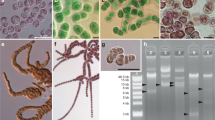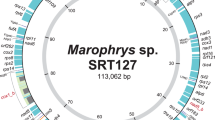Abstract
Plastid genomes of the peridinin-containing dinoflagellates are composed of a limited number of genes that are contained separately on small circular molecules (minicircles). It has been shown that occasionally aberrant minicircles are generated, but they are usually small and contain little coding information. In this study, we discovered multiple variants, a putative “gene family”, of the gene psbA in the plastid minicircles of the dinoflagellate Alexandrium tamarense, which have persisted for almost 3 years in culture. Each variant, like the ordinary psbA, existed on distinct minicircles of similar size (5–6 kb). These psbA variants retained all, or almost all, the coding sequence of the ordinary gene, and all four were transcribed and edited after transcription, even though they could not encode the entire protein due to intervening or translocated sequences. Repeat elements were generally found in the relatively large non-coding region of these minicircles. Each psbA variant might have been generated by DNA recombination and/or replication slippage, as for previously reported aberrant minicircles. The fact that these minicircles are transcribed, individually edited and maintained in the genome suggests that they are functionally important, although their precise roles remain unclear.


Similar content being viewed by others
References
Bachvaroff TR, Concepcion GT, Rogers CR, Herman EM, Delwiche CF (2003) Dinoflagellate expressed sequence tag data indicate massive transfer of chloroplast genes to the nuclear genome. Protist 155:65–78
Barbrook AC, Howe CJ (2000) Minicircular plastid DNA in the dinoflagellate Amphidinium operculatum. Mol Gen Genet 263:152–158
Barbrook AC, Symington H, Nisbet RER, Larkum A, Howe CJ (2001) Organisation and expression of the plastid genome of the dinoflagellate Amphidinium operculatum. Mol Genet Genomics 266:632–638
Barbrook AC, Visram S, Douglas AE, Howe CJ (2006a) Molecular diversity of dinoflagellate symbionts of Cnidaria: the psbA minicircle of Symbiodinium. Protist 157:159–171
Barbrook AC, Santucci N, Plenderleith LJ, Hiller RG, Howe CJ (2006b) Comparative analysis of dinoflagellate chloroplast genomes reveals rRNA and tRNA genes. BMC Genomics 7:297
Bedbrook JR, Kolodner R (1979) The structure of chloroplast DNA. Ann Rev Plant Physiol 30:593–620
Birky CW Jr (1983) Relaxed cellular controls and organelle heredity. Science 222:468–475
Birky CW Jr (2001) The inheritance of genes in mitochondria and chloroplasts: laws, mechanisms and models. Annu Rev Genet 35:125–148
Bock R (2001) Transgenic plastids in basic research and plant biotechnology. J Mol Biol 312:425–438
Bock R (2007) Structure, function, and inheritance of plastid genomes. In: Bock R (ed) Cell and molecular biology of plastids. Topics in current genetics, vol 19. Springer, Berlin, pp 29–63
Day A, Madesis P (2007) DNA replication, recombination, and repair in plastids. In: Bock R (ed) Cell and molecular biology of plastids. Topics in current genetics, vol 19. Springer, Berlin, pp 65–119
Douglas S (1994) Chloroplast origins and evolution. In: Bryant DA (ed) The molecular biology of cyanobacteria. Kluwer, Dordrecht, pp 91–118
Golden S (1994) Light-responsive gene expression and the biochemistry of the photosystem II reaction center. In: Bryant DA (ed) The molecular biology of cyanobacteria. Kluwer, Dordrecht, pp 693–714
Green BR (2004) The chloroplast genome of dinoflagellates—a reduced instruction set? Protist 155:23–31
Hackett JD, Bhattacharya D (2006) The genomes of dinoflagellates. In: Katz LA, Bhattacharya D (eds) Genomics and evolution of microbial eukaryotes. Oxford University Press, New York, pp 48–63
Hackett JD, Yoon HS, Soares MB, Bonaldo MF, Casavant TL, Scheetz TE, Nosenko T, Bhattacharya D (2004) Migration of the plastid genome to the nucleus in a peridinin dinoflagellate. Curr Biol 14:213–218
Hackett JD, Scheetz TE, Yoon HS, Soares MB, Bonaldo MF, Casavant TL, Bhattacharya D (2005) Insights into a dinoflagellate genome through expressed sequence tag analysis. BMC Genomics 6:80
Hiller RG (2001) ‘Empty’ minicircles and petB/atpA and psbD/psbE (cytb 559 α) genes in tandem in Amphidinium carterae plastid DNA. FEBS Lett 505:449–452
Howe CJ, Nisbet RER, Barbrook AC (2008) The remarkable chloroplast genome of dinoflagellates. J Exp Bot 59:1035–1045
Iida S, Kobiyama A, Ogata T, Murakami A (2008) The D1 and D2 proteins of dinoflagellates: unusually accumulated mutations which influence on PSII photoreaction. Photosynth Res 98:415–425
Iwasaki H (1961) The life-cycle of Porphyra tenera in vitro. Biol Bull 121:173–187
Khakhlova O, Bock R (2006) Elimination of deleterious mutations in plastid genomes by gene conversion. Plant J 46:85–94
Kobiyama A, Ikeda Y, Koike K, Ogata T (2006) Isolation of a differentially expressed gene in separate mating types of the dinoflagellate A. tamarense. Eur J Phycol 42:183–190
Kumar S, Tamura K, Nei M (2004) MEGA3: integrated software for molecular evolutionary genetics analysis and sequence alignment. Briefings Bioinformat 5:150–163
Laatsch T, Zauner S, Stoebe-Maier B, Kowallik KV, Maier U-G (2004) Plastid-derived single gene minicircles of the dinoflagellate Ceratium horridum are localized in the nucleus. Mol Biol Evol 21:1318–1322
Lajeunesse TC, Lambert G, Anderson RA, Coffroth MA, Galbraith DW (2005) Symbiodinium (Pyrrhophyta) genome sizes (DNA content) are smallest among dinoflagellates. J Phycol 41:880–886
Liu Y-G, Mitsukawa N, Oosumi T, Whittier RF (1995) Efficient isolation and mapping of Arabidopsis thaliana T-DNA insert junctions by thermal asymmetric interlaced PCR. Plant J 8:457–463
Maier RM, Schmitz-Linneweber C (2004) Plastid genomes. In: Daniel H, Chase CD (eds) Molecular biology and biotechnology of plant organelles. Springer, Dordrecht, pp 115–150
Moore RB, Ferguson KM, Loh WKW, Hoegh-Guldberg O, Carter DA (2003) Highly organized structure in the non-coding region of the psbA minicircle from clade C Symbiodinium. Int J Syst Evol Microbiol 53:1725–1734
Nelson MJ, Green BR (2005) Double hairpin elements and tandem repeats in the non-coding region of Adenoides eludens chloroplast gene minicircles. Gene 358:102–110
Nelson MJ, Dang Y, Filek E, Zhang Z, Yu VWC, Ishida K-I, Green BR (2007) Identification and transcription of transfer RNA genes in dinoflagellate plastid minicircles. Gene 392:291–298
Nisbet RER, Koumandou VL, Barbrook AC, Howe CJ (2004) Novel plastid gene minicircles in the dinoflagellate Amphidinium operculatum. Gene 331:141–147
Nisbet RER, Hiller RG, Barry ER, Skene P, Barbrook AC, Howe CJ (2008) Transcript analysis of dinoflagellate plastid gene minicircles. Protist 159:31–39
Palmer JD (1985) Comparative organization of chloroplast genomes. Ann Rev Genet 19:325–354
Palmer JD (2003) The symbiotic birth and spread of plastids: how many times and whodunit? J Phycol 39:4–11
Palmer JD, Delwiche CF (1998) The origin and evolution of plastids and their genomes. In: Soltis DE, Soltis PS, Doyle JJ (eds) Molecular systematics of plants II: DNA sequencing. Kluwer, Boston, pp 375–409
Rochaix JD (1995) Chlamydomonas reinhardtii as the photosynthetic yeast. Annu Rev Genet 29:209–230
Sambrook J, Russell DW (2001) Molecular cloning: a laboratory manual, 3rd edn. Cold Spring Harbor Laboratory Press, Cold Spring Harbor
Santos SR, Taylor DJ, Kinzie RA III, Sakai K, Coffroth MA (2002) Evolution of length variation and heteroplasmy in the chloroplast rDNA of symbiotic dinoflagellates (Symbiodinium, Dinophyta) and a novel insertion in the universal core region of the large subunit rDNA. Phycologia 41:311–318
Satoh K, Wydrzynski TJ, Govindjee (2005) Introduction to photosystem II. In: Wydrzynski TJ, Satoh K (eds) Advances in photosynthesis and respiration (vol 22). Photosystem II: the light-driven water: plastoquinone oxidoreductase. Springer, Dordrecht, pp 11–22
Shikanai T, Obokata J (2008) Machinery of RNA editing in plant organelles. In: Smith HC (ed) RNA and DNA editing: molecular mechanisms and their integration into biological systems. Wiley, Hoboken, pp 99–119
Sicora CI, Appleton SE, Brown CM, Chung J, Chandler J, Cockshutt AM, Vass I, Campbell DA (2006) Cyanobacterial psbA families in Anabaena and Synechocystis encode trace, constitutive and UVB-induced D1 isoforms. Biochim Biophys Acta 1757:47–56
Sicora CI, Brown CM, Cheregi O, Vass I, Campbell DA (2008) The psbA gene family responds differentially to light and UVB stress in Gloeobacter violaceus PCC 7421, a deeply divergent cyanobacterium. Biochim Biophys Acta 1777:130–139
Simpson CL, Stern DB (2002) The treasure trove of algal chloroplast genomes. Surprises in architecture and gene content, and their functional implications. Plant Physiol 129:957–966
Stern DB, Gruissem W (1987) Control of plastid gene expression: 3’ inverted repeats act as mRNA processing and stabilizing elements, but do not terminate transcription. Cell 51:1145–1157
Sugiura M (1992) The chloroplast genome. Plant Mol Biol 19:149–168
Takishita K, Uchida A (1999) Molecular cloning and nucleotide sequence analysis of psbA from the dinoflagellates: origin of the dinoflagellate plastid. Phycol Res 47:207–216
Waller RF, Patron NJ, Keeling PJ (2006) Phylogenetic history of plastid-targeted proteins in the peridinin-containing dinoflagellate Heterocapsa triquetra. Int J Syst Evol Microbiol 56:1439–1447
Wang Y, Morse D (2006a) The plastid-encoded psbA gene in the dinoflagellate Gonyaulax is not encoded on a minicircle. Gene 371:206–210
Wang Y, Morse D (2006b) Rampant polyuridylylation of plastid gene transcripts in the dinoflagellate Lingulodinium. Nucleic Acid Res 34:613–619
Zauner S, Greilinger D, Laatsch T, Kowallik KV, Maier U-G (2004) Substitutional editing of transcripts from genes of cyanobacterial origin in the dinoflagellate Ceratium horridum. FEBS Lett 577:535–538
Zhang Z, Green BR, Cavalier-Smith T (1999) Single gene circles in dinoflagellate chloroplast genomes. Nature 400:155–159
Zhang Z, Cavalier-Smith T, Green BR (2001) A family of selfish minicircular chromosomes with jumbled chloroplast gene fragments from a dinoflagellate. Mol Biol Evol 18:1558–1565
Zhang Z, Cavalier-Smith T, Green BR (2002) Evolution of dinoflagellate unigenic minicircles and the partially concerted divergence of their putative replicon origins. Mol Biol Evol 19:489–500
Zoschke R, Liere K, Börner T (2007) From seedling to mature plant: Arabidopsis plastidial genome copy number, RNA accumulation and transcription are differentially regulated during leaf development. Plant J 50:710–722
Acknowledgments
We are grateful to Professor Emeriti, Masahiro Sugiura (Nagoya University) and Kimiyuki Satoh (Okayama University), for critical reading of the manuscript and for many valuable discussions. Color illustrations were prepared by Ms. H. Uchida. Sequencing was assisted by the Kobe University Research Center for Environmental Genomics. This study was supported by a Grant-in-Aid for Creative Scientific Research (No. 17GS0314 to A.M.) from the Japan Society for the Promotion of Science and partly by the Sasakawa Scientific Research Grant from The Japan Science Society (No. 21-745M to S. I.).
Author information
Authors and Affiliations
Corresponding author
Additional information
Communicated by F.-A. Wollman.
Nucleotide sequence data reported are available in the DDBJ/EMBL/GenBank databases under the accession numbers: AB359447–AB359456.
Electronic supplementary material
Below is the link to the electronic supplementary material.
Rights and permissions
About this article
Cite this article
Iida, S., Kobiyama, A., Ogata, T. et al. Identification of transcribed and persistent variants of the psbA gene carried by plastid minicircles in a dinoflagellate. Curr Genet 55, 583–591 (2009). https://doi.org/10.1007/s00294-009-0271-9
Received:
Accepted:
Published:
Issue Date:
DOI: https://doi.org/10.1007/s00294-009-0271-9




